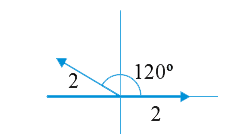The resultant of two vectors makes an angle of 60∘ with one vector and 30∘ with one other. If the magnitude of resultant is 25, the two vectors are of magnitude
24,7
12,5
12.5,12.5√3
15.7,15.7√2
The correct Answer is:C
To solve the problem, we need to find the magnitudes of two vectors →A and →B given that their resultant →R makes angles of 60∘ with →A and 30∘ with →B, and the magnitude of the resultant is 25.
1. Understand the Geometry:
We have two vectors →A and →B with a resultant →R. The angles given are:
- ∠R→A=60∘
- ∠R→B=30∘
2. Use the Law of Cosines:
The magnitude of the resultant vector can be expressed in terms of the magnitudes of →A and →B and the angles between them. However, we can also use the components of the vectors based on the angles provided.
3. Resolve →A and →B:
- The component of →A along the direction of →R is:
A=R⋅cos(60∘)=25⋅12=12.5
- The component of →B along the direction of →R is:
B=R⋅sin(60∘)=25⋅√32=12.5√3
4. Final Magnitudes:
- Thus, the magnitudes of the vectors are:
- |→A|=12.5
- |→B|=12.5√3
5. Conclusion:
The magnitudes of the two vectors are 12.5 and 12.5√3.
We have two vectors →A and →B with a resultant →R. The angles given are:
- ∠R→A=60∘
- ∠R→B=30∘
The magnitude of the resultant vector can be expressed in terms of the magnitudes of →A and →B and the angles between them. However, we can also use the components of the vectors based on the angles provided.
- The component of →A along the direction of →R is:
A=R⋅cos(60∘)=25⋅12=12.5
- The component of →B along the direction of →R is:
B=R⋅sin(60∘)=25⋅√32=12.5√3
- Thus, the magnitudes of the vectors are:
- |→A|=12.5
- |→B|=12.5√3
The magnitudes of the two vectors are 12.5 and 12.5√3.
Topper's Solved these Questions
- MOTION IN A PLANEBOOK - AAKASH INSTITUTE ENGLISHCHAPTER - MOTION IN A PLANEEXERCISE - Assignement section -B Objective (one option is correct)
29 Videos
- MOTION IN A PLANEBOOK - AAKASH INSTITUTE ENGLISHCHAPTER - MOTION IN A PLANEEXERCISE - Assignement section -C Objective (More than one option is correct)
7 Videos
- MOTION IN A PLANEBOOK - AAKASH INSTITUTE ENGLISHCHAPTER - MOTION IN A PLANEEXERCISE - Try yourself
48 Videos
- MOCK_TEST_17BOOK - AAKASH INSTITUTE ENGLISHCHAPTER - MOCK_TEST_17EXERCISE - Example
15 Videos
- MOTION IN A STRAIGHT LINEBOOK - AAKASH INSTITUTE ENGLISHCHAPTER - MOTION IN A STRAIGHT LINEEXERCISE - ASSIGNMENT (SECTION - D)
15 Videos
Similar Questions
A resultant of two vectors makes 30∘ with one vector and 45∘ with the other. Find the two vectors if the resultant has the magnitude 15
View SolutionResultant of two vector of equal magnitude A is
View SolutionIs it possible that the magnitude of resultantof two vectors is equal toeach of the vectors ?
View SolutionCan the resultant of two vector be zero
View SolutionThe resultant of two vectors , having equal magnitudes E make an angle of 120∘ with each other . What is the magnitude and direction of the resultant ?
View SolutionIf three unit vectors are inclined at an angle of 60∘ with each other, then the magnitude of their resultant vector will be
View SolutionThe resultant of two vectors at right angles is 5 N. If the angle between them is 120∘ and the resultant is √13 then the magnitude of vectors are
View SolutionTwo vectors 3 units and 5 units are acting at 60∘ to each other .What is the magnitude and direction of the resultant ?
View SolutionFind the magnitude and direction of the resultant of given vectors

View SolutionTwo vectors having equal magnitudes A make an angle θ with eahc other. Find the magnitude and direction of the resultant.
View Solution
